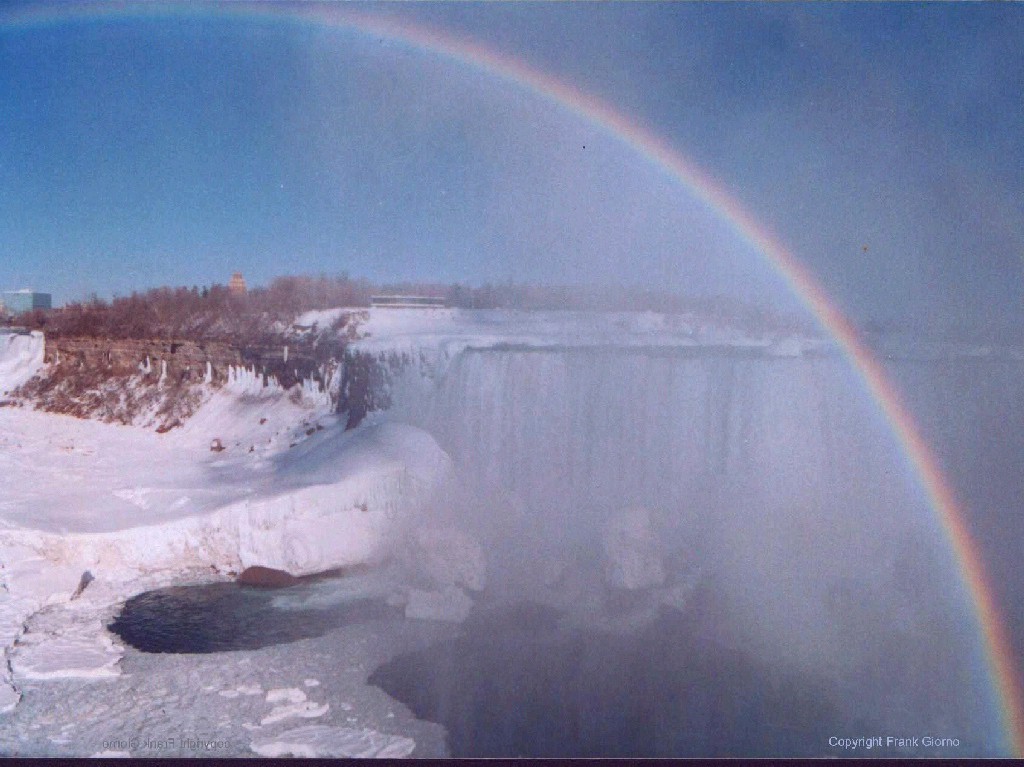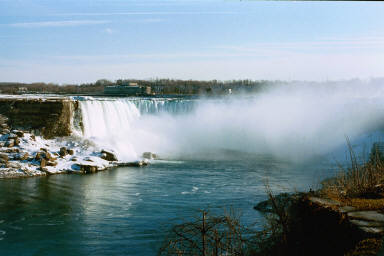
There is something about the sight and sound of water cascading over a rocky precipice that stirs our souls. The seething white, foaming water tumbling over the crest of rock, the thundering roar of the water crashing on the rocks below. Nothing evokes this sensation better than Niagara Falls.
In 1678, Father Louis Hennepin, a Recollet missionary became one of the first Europeans to see Niagara Falls. In his book "A New Discovery of a Vast Country in America," Father Hennepin describes the impact the sight had on him. He wrote:
"Between Lakes Ontario and Erie, there is a vast and prodigious cadence of water which falls down after a surprising and astonishing manner, insomuch that the universe does not afford its parallel...... The waters which fall from this horrible precipice, do foam and boil after the most hideous manner imaginable, making an outrageous noise, more terrible than thunder; for when the wind blows out of the south, their dismal roaring can be heard more than fifteen leagues off."
What Father Hennepin may not have realised is that Niagara Falls is but one of more than 60 waterfalls that have been created by the rivers and creeks that tumble over the Niagara Escarpment. If you, like Father Hennepin, enjoy exploring waterfalls, you are in luck. Within an hour or two from Toronto the Niagara Escarpment provides opportunities to view up to 60 waterfalls. I have visited many of them and would like to share with you some of the photographs I have taken and some of the lessons I have learned about the beauty and the importance of waterfalls.
Stretching 520 km (323 miles) from Niagara to Tobermory at the tip of the Bruce Peninsula, the Escarpment is southern Ontario's most significant geographical feature. In 1990, the UNESCO recognized its significance by declaring the Niagara Escarpment a world biosphere reserve. One of only six biosphere reserves in Canada.
The Niagara Escarpment was formed by the power of water cutting into soft sedimentary rock over hundreds of millions of years. This sedimentary rock known as Queenston shale dates back 400 million years when a warm sea covered what geologists today call the Michigan basin. A hard layer of rock known as lockport dolomite covers the soft sedimentary rock. The soft underlayer was eroded first by the advancing glaciers and then again when they receded. When the glaciers receded they left behind a steep escarpment sliced by rivers and streams which cascaded over its edge. The long period of erosion that follwed helped create the shape and features of the escarpment we see today. Through a pocess known as "sapping", swirling waters of the waterfalls erode the soft Queenston shale until it undermined the Lockport dolomite above it until the hard dolomite breaks off. This process has resulted in the formation of deep gorges along the rivers and creeks that tumble over the escarpment.
If viewed from a satelite, the Niagara Escarpment is shaped like a horseshoe that streteches from a point near Rochester, New York and cuts through Ontario beginning at Queenston, north of Niagara Falls. From Queenston, the escarpment follows a path through the Niagara Peninsula westward towards Hamilton. In Hamilton the escarpment is known locally as "the Mountain". The escarpment wraps itself around the Hamilton-Ancaster-Dundas-Burlington area and then travels north- eastward towards Georgetown a point north of Oakville. It then veers north and continues up to the Blue Mountains by Georgian Bay near Collingwood . The escarpment then travels west towards Owen Sound where it turns northward along the Bruce Peninsula. At Tobermory at the northern most tip of the Bruce Peninsula, the escarpment plunges under the waters of Georgian Bay and resurfaces on Manitoulin Island and a string of islands that stretch west ward along the North Channel of Lake Huron where it disappears underwater until it resurfaces on the western side of Lake Michigan where it veers south and finally peters out near Green Bay, Wisconsin.

Actually, Niagara Falls is no longer situated on the Niagara Escarpment. Niagara Falls used to be part of the Niagara Escarpment when it was situated near in Queenston, but that was over 12,000 years. Since then Niagara Falls have moved 11 kilometres (seven miles ) southerly to its present location as a result of erosion. The force of the Falls have created a gorge seven miles long. At one time the Falls eroded at a rate of one metre per year (three and half feet). But since the early 1950's the rate has slowed to 3 centimetres a year because of a major water diversion for the Adam Beck #2 Generating Station and the building of an international control work. As a result of these projects the flow of water was spread over more evenly across the crest line of the Falls and reduced stress which causes erosion.
Niagara Falls stands in a class of its own. Although 50 other falls are taller than Niagara, the tallest being the Angels Falls in Venezuela at 979 metres (3,212 ft), most of these taller falls do not have the volume of water that the Niagara Falls has. Even though it is not officially listed as one of the seven wonders of nature, the combination of height, width and volume make Niagara a wonder to behold. The Canadian Horseshoe Falls is 52 metres in height (170 feet). The American Falls at its tallest point is 34 metres (110 ft). The crest line of the Horseshoe Falls is 670 metres (2, 200 ft).
 The American Falls has a crest line of 260 metres (850 feet). In other words, the combined Horseshoe Falls and American Falls are as wide as the Angel Falls is long. The total volume of water that pours over the Horseshoe Falls is a staggering 160,000 cubic metres (6 million cubic feet) per minute. It's no wonder that since the time of Father Hennepin, Niagara Falls has become one of the most visited attractions on earth. The Niagara Parks Commission estimates 10 to 12 million people each year come from all over the world to view one of nature's wonders.
The American Falls has a crest line of 260 metres (850 feet). In other words, the combined Horseshoe Falls and American Falls are as wide as the Angel Falls is long. The total volume of water that pours over the Horseshoe Falls is a staggering 160,000 cubic metres (6 million cubic feet) per minute. It's no wonder that since the time of Father Hennepin, Niagara Falls has become one of the most visited attractions on earth. The Niagara Parks Commission estimates 10 to 12 million people each year come from all over the world to view one of nature's wonders.